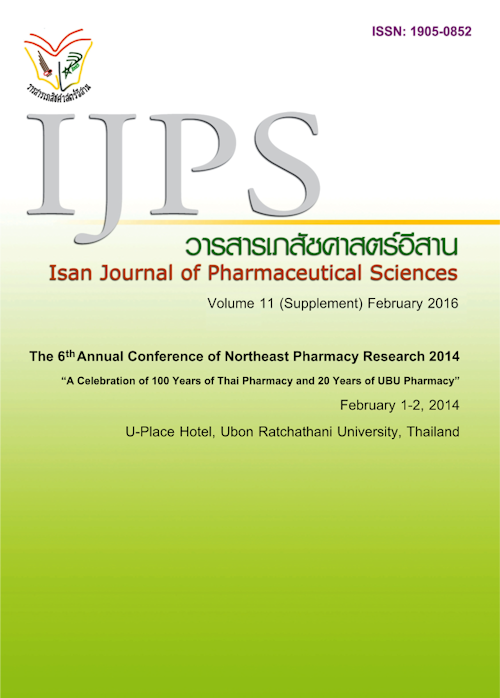Study of Cefazolin Entrapment and Release From Hydrogel Patch Comprising of Natural Rubber and Modified Starch
Main Article Content
Abstract
Introduction: The previous studies have found that the hydrogels prepared from rubber and starch have good swelling and water absorption property. Therefore, this study have hypothesized that the hydrogels prepared by this method can be entrap and release cefazolin. This study aimed to determine the entrapment and release of cefazolin from hydrogel patch comprising of crosslinked natural rubber and modified rice/banana starch. Materials and Method: Hydrogels prepared from rubber and starch by Free radical polymerlization. Direct addition method was employed for cefazolin entrapment with initial concentrations 100 µg/ml. High Performance Liquid Chromatography (HPLC) was utilized for cefazolin quantitative analysis and evaluate % weight loss. Results: The results showed that the initial concentration 100 µg/ml was able to use for loading cefazolin in direct addition method. The patch containing mBSt provided no significant (p > 0.05) greater cefazolin entrapment than the patch containing mRSt (393.84 µg and 290 µg, respectively).As the release profile, the drug is released rapidly within 4 hours then drug released from rubber will be stable within 24 hours whereas drug released from hydrogel still tend to increase and it showed that the patch containing mRSt provided significantly more rapid release than in patch containing mBSt (p < 0.05) (the initial drug release 113.24% and 79.10% within 3 hours, respectively). Conclusion: direct addition method was successfully used for cefazolin in hydrogel-transdermal patch comprising of natural rubber and modified rice/banana starch by the initial loading concentration 100 µg/ml. IPN hydrogel demonstrated cefazolin entrapment efficiency and release (at 24 hour) 2.77-14.84 µg/cm2 and 133-184%, respectively. To obtain higher drug release, higher drug loading initial concentration are required in further study. There should study cefazolin releasing profile from the hydrogel at higher concentrations.
Article Details
In the case that some parts are used by others The author must Confirm that obtaining permission to use some of the original authors. And must attach evidence That the permission has been included
References
Farstvedt E, Stashak TS, Diplomate MS, et al. Update on Topical Wound Medications. Clin Tech Equine Pract 2004; 3: 164-172.
Grayson ML, McDonald M, Gibson K, et al. Once-Daily Intravenous Cefazolin Plus Oral Probenecid Is Equivalent to Once-Daily Intravenous Ceftriaxone Plus Oral Placebo for the Treatment of Moderate-to-Severe Cellulitis in Adults. CID 2002; 34(11): 1440-1448.
Puapermpoonsiri: U., Pratoomtec, J., Sila-On, W., Watjung, c. Water Absorption and Swelling Property of Interpenetrating Network Hydrogel from Crosslinked Natural Rubber and Modified Rice starch. Advance Materials Research Journal 2014; 844: 73-76.
Sila-On W, Pratoomted J, Puapermpoonsiri U, Watjung c, Pitchayakom W. Thermal and Mechanical Properties of Natural Rubber/Rice Starch Interpenetrating Network Hydrogel. Advance Materials Research Journal 2014; 844: 77-80.


